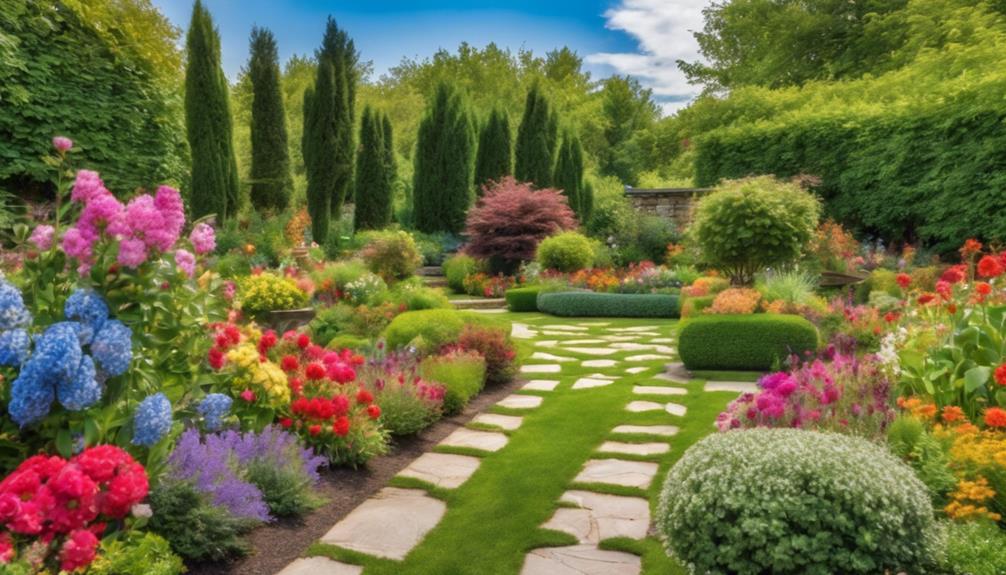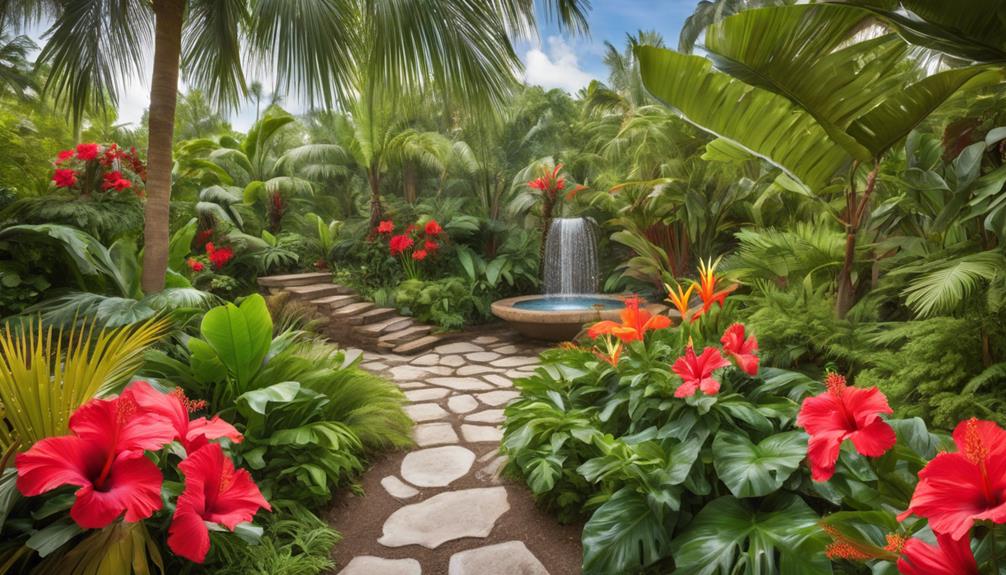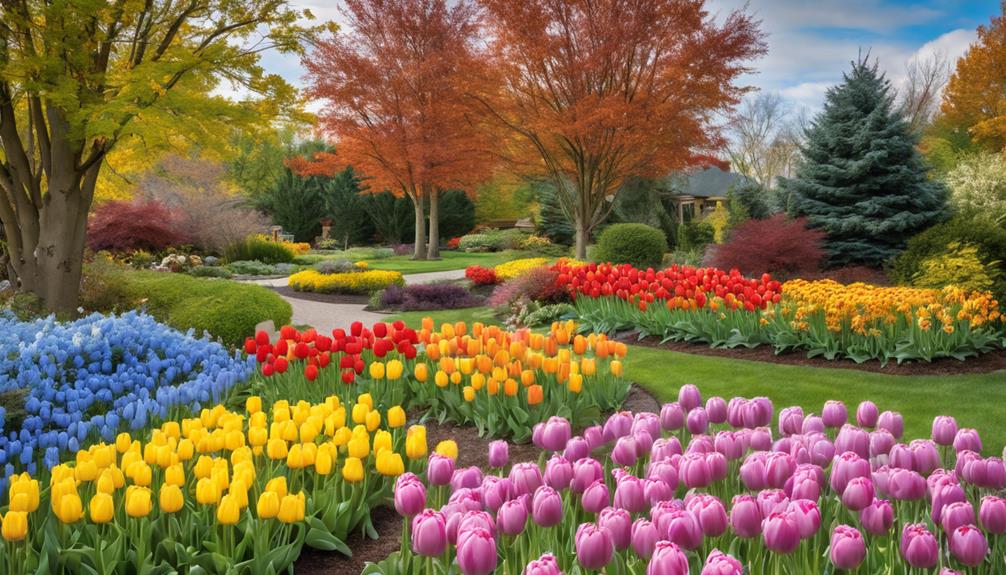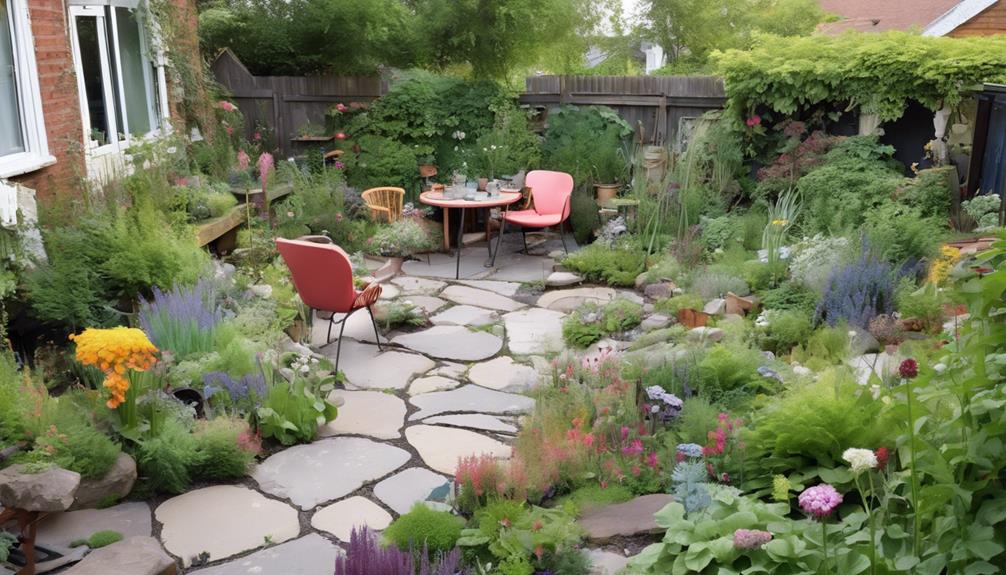
Winter-Ready: Top 10 Garden Cleanup Tips
12 February 2025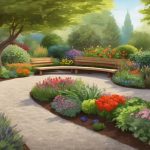
Simple Garden Design Ideas for Beginners
13 February 2025Thoughtful garden design is essential for enhancing curb appeal and increasing property value. Key principles such as balance, focal points, and plant layering create visual harmony.
Selecting a mix of native plants ensures adaptability and low maintenance, contributing to a sustainable landscape.
Furthermore, incorporating hardscaping features can expand usable outdoor space while providing seasonal interest through varied colours and textures.
Effective planning not only beautifies but also enhances functionality.
For those looking to elevate their outdoor spaces, the possibilities are vast and inviting, paving the way for a stunning transformation that captivates both the eye and the environment.
Garden Design Essentials Explained
Understanding key design principles is vital for creating an appealing garden that enhances curb appeal.
In addition to these principles, selecting the right plants can significantly influence the overall aesthetic and maintenance of the garden.
This discussion will highlight important strategies for effective garden design.
Key Design Principles
Creating a visually appealing garden requires a thoughtful approach to design principles that enhance both functionality and aesthetics.
To begin with, balance is crucial, harmonising elements such as plants, paths, and structures to create a cohesive look. Consider scale and proportion; ensure features complement each other and fit the space effectively.
Next, establish a focal point to draw the eye, whether it be a striking sculpture or a vibrant flower bed. Incorporating rhythm through the repetition of colours, shapes, or textures boosts visual flow.
Furthermore, layering plants provides depth and interest, while varying heights adds dimension.
Lastly, maintain a sense of unity by connecting disparate elements through a consistent style or theme, ensuring each component works together to create an inviting, polished environment.
Plant Selection Tips
Selecting the right plants is a fundamental aspect of garden design that directly impacts both aesthetics and maintenance. To achieve a cohesive and inviting landscape, consider the following tips.
To begin, assess your climate and soil conditions, as these will dictate plant viability. Choose a mix of perennials and annuals for continuous interest throughout the seasons, while incorporating native species to enhance biodiversity and reduce upkeep.
Pay attention to the plants' mature size, ensuring they fit harmoniously within the available space. Furthermore, consider texture, colour, and form; contrasting elements enhance visual appeal.
Plant Selection Criteria
Selecting the right plants for curb appeal requires careful consideration of several key factors.
Evaluating soil quality, understanding specific plant growth requirements, and assessing the climate adaptability of chosen species are crucial steps in this process.
These criteria ensure that the garden flourishes while enhancing the overall visual appeal of the property.
Soil Quality Assessment
To achieve a thriving garden that enhances curb appeal, a thorough assessment of soil quality is essential for informed plant selection.
Understanding the characteristics of the soil enables gardeners to choose plants that will thrive in their environment and contribute to the overall aesthetic appeal.
- pH Level: Determines nutrient availability and plant compatibility.
- Texture: Influences water retention and root penetration.
- Organic Matter Content: Improves soil fertility and structure.
- Drainage Capacity: Affects moisture levels and root health.
Plant Growth Requirements
Understanding soil quality lays the groundwork for determining the specific plant growth requirements necessary for a successful garden design.
Effective plant selection hinges on several critical factors, ensuring optimum growth and aesthetic appeal.
- Soil Type: Different plants thrive in sandy, loamy, or clay soils, which influence water retention and nutrient availability.
- pH Levels: Most plants prefer a slightly acidic to neutral pH, which impacts nutrient absorption and overall health.
- Nutrient Content: Adequate levels of nitrogen, phosphorus, and potassium are essential for robust plant development.
- Moisture Levels: Understanding the drainage capacity of your soil helps in selecting plants that suit wet or dry conditions.
Ultimately, these criteria guide the selection process, fostering a vibrant and sustainable garden.
Climate Adaptability of Plants
Climate adaptability is a crucial factor in plant selection, as it determines how well a species can thrive in varying environmental conditions.
Choosing plants that can withstand local climate fluctuations enhances garden resilience and aesthetics.
Consider the following criteria when selecting climate-adaptable species:
- Drought Tolerance: Prioritise plants that require minimal watering, particularly in arid regions.
- Frost Resistance: Select varieties that can survive low temperatures to minimise winter damage.
- Humidity Preference: Understand the moisture needs of plants to ensure compatibility with local humidity levels.
- Soil Adaptability: Opt for plants that can thrive in a range of soil types, thereby improving biodiversity and soil health.
Plan Your Garden Layout
When planning your garden layout, it is crucial to initially define the garden's purpose to ensure functionality and aesthetic appeal.
Incorporating native plants can enhance biodiversity while requiring less maintenance, making them a prudent choice for any garden design.
Furthermore, employing vertical gardening strategies can optimise space and create a visually striking focal point.
Define Your Garden's Purpose
Defining your garden's purpose is essential for crafting an effective layout that enhances both functionality and aesthetics.
A well-thought-out design ensures that each element serves a distinct role, elevating the overall appeal of your property.
Consider the following aspects when determining your garden's purpose:
- Entertainment Space: Create areas for gatherings, barbecues, or quiet reflection.
- Children's Play Area: Design safe zones for children to explore and play.
- Edible Garden: Incorporate vegetable patches or herb beds for fresh produce.
- Wildlife Habitat: Encourage biodiversity by attracting beneficial insects and birds.
Use Native Plants Wisely
Incorporating native plants into your garden design can significantly enhance both the ecological health and aesthetic appeal of your landscape.
By selecting the right species, you can create a cohesive and vibrant environment that attracts local wildlife while minimising maintenance efforts.
Consider these strategies for ideal integration:
- Select Local Species: Choose plants that are indigenous to your region for improved adaptability.
- Group Plants Strategically: Plant in clusters to enhance visual impact and mimic natural ecosystems.
- Incorporate Seasonal Interest: Mix early bloomers with late-season flowers for year-round appeal.
- Create Diverse Habitats: Utilise different heights and textures to support a variety of wildlife.
Vertical Gardening Strategies
To optimise limited space and enhance curb appeal, vertical gardening strategies provide a creative approach to garden layout.
Employing vertical gardening not only maximises your planting area but also increases visual interest.
Consider the following strategies to master your vertical garden design:
- Living Walls: Install modular systems that enable plants to thrive vertically, creating a lush, green façade.
- Trellises and Arbours: Use structures to support climbing plants, which can create stunning focal points.
- Hanging Planters: Utilise ceiling space or wall-mounted brackets to add depth and dimension.
- Vertical Planters: Explore pocket gardens or stacked planters for an efficient use of space while showcasing a variety of plants.
Incorporating these elements will elevate your garden's aesthetic and overall attractiveness.
Increased Property Value Potential
A well-designed garden can significantly enhance the overall appeal of a property, making it more attractive to prospective buyers. Investing in thoughtful garden design not only elevates aesthetic value but also contributes to increased potential for property value. A beautifully landscaped garden provides a strong initial impression, which can greatly influence buyers' perceptions and decisions.
| Design Element | Impact on Property Value |
|---|---|
| Native Plant Selection | Boosts biodiversity |
| Hardscaping Features | Increases usable space |
| Seasonal Colour Schemes | Attracts year-round interest |
| Outdoor Lighting | Extends usability and safety |
Ultimately, an appealing garden serves as an investment, yielding substantial returns by enhancing the market value of the property.
Sustainable Landscaping Techniques
Sustainable landscaping techniques play an essential role in enhancing curb appeal while promoting environmental stewardship.
Implementing rainwater harvesting systems, utilising compost for soil enrichment, and applying mulch for moisture retention are effective strategies that not only improve the aesthetics of a property but also contribute to resource conservation.
These practices create a resilient landscape that thrives with minimal ecological impact.
Rainwater Harvesting Systems
Integrating rainwater harvesting systems into garden design significantly enhances both functionality and sustainability.
These systems not only reduce water bills but also improve the landscape's eco-friendliness.
Consider the following benefits:
- Water Conservation: Efficiently captures and stores rainwater for irrigation, minimising reliance on municipal supplies.
- Soil Health: Reduces erosion and runoff, allowing water to percolate and recharge groundwater.
- Biodiversity Support: Encourages diverse plant growth by providing a consistent water source, promoting a resilient ecosystem.
- Aesthetic Appeal: Incorporates visually pleasing elements such as rain gardens and decorative cisterns that enrich the entire landscape design.
Compost for Soil Enrichment
Utilising compost for soil enrichment is a highly effective practice in sustainable landscaping that yields numerous benefits for garden health. By incorporating compost into your soil, you improve its structure and fertility, promoting robust plant growth.
Here are four key advantages of using compost:
- Nutrient-Rich Organic Matter: Compost provides crucial nutrients that support plant health and vigour.
- Improved Soil Structure: It enhances soil aeration and water retention, facilitating better root development.
- Microbial Life Support: Compost fosters beneficial microorganisms that contribute to a thriving ecosystem within the soil.
- pH Balance: It aids in stabilising soil pH, creating an ideal environment for a diverse range of plants.
Incorporating compost as a foundational practice will enhance your garden's overall success and sustainability.
Mulching for Moisture Retention
In conjunction with composting, mulching serves as an effective technique for improving moisture retention in garden beds.
This sustainable practice not only conserves water but also enhances soil health.
Here are four critical benefits of mulching:
- Weed Suppression: A thick layer of mulch inhibits weed growth, reducing competition for moisture.
- Temperature Regulation: Mulch acts as an insulating layer, maintaining consistent soil temperatures.
- Erosion Control: It protects the soil from erosion caused by heavy rain, ensuring moisture remains intact.
- Organic Matter Improvement: As mulch decomposes, it enriches the soil with organic matter, promoting microbial activity.
Implementing mulching effectively allows gardeners to create resilient ecosystems while significantly enhancing curb appeal.
Pest Management Strategies
Effective pest management begins with understanding the foundational elements of your garden's ecosystem, including soil health and irrigation practices.
Implementing soil erosion prevention techniques not only protects your plants but also enhances the soil's capacity to support beneficial microorganisms.
Furthermore, adjusting soil pH and utilising efficient irrigation methods can significantly reduce pest populations by fostering a balanced environment for your garden.
Soil Erosion Prevention Techniques
Soil erosion is often a significant concern in garden design, as it can undermine the integrity of both the landscape and the plants within it. Effective erosion prevention techniques are vital for maintaining a thriving garden.
Consider the following strategies:
- Ground Cover Plants: Utilise deep-rooted vegetation to stabilise soil and reduce runoff.
- Mulching: Apply organic or inorganic materials to protect soil from erosion and retain moisture.
- Terracing: Create level areas on slopes to slow water flow and enhance absorption.
- Retaining Walls: Implement structures to hold back soil and prevent erosion in steep areas.
Soil Ph Adjustment Techniques
Achieving the ideal pH level in garden soil is crucial for effective pest management and thorough plant health. A balanced pH ensures that nutrients are available to plants while creating an environment less conducive to pests.
Implement the following techniques for soil pH adjustment:
- Lime Application: Use agricultural lime to raise soil pH, effectively reducing acidity.
- Sulphur Supplement: Incorporate elemental sulphur to lower pH levels in alkaline soils.
- Organic Matter: Amend soil with compost or well-rotted manure to stabilise pH and improve microbial activity.
- Regular Testing: Conduct soil tests to monitor pH levels, ensuring timely adjustments for optimal health.
Effective Irrigation Techniques
Irrigation plays a pivotal role in pest management strategies within garden design, impacting both plant health and pest dynamics. An effective irrigation system not only guarantees ideal moisture levels but also deters pests that thrive in overly saturated conditions.
Here are four techniques to consider:
- Drip Irrigation: Targets root zones directly, minimising water waste and reducing fungal diseases.
- Soaker Hoses: Promote even moisture distribution, preventing surface runoff that can attract pests.
- Rainwater Harvesting: Utilises natural rainfall, lessening dependency on municipal water and enhancing nutrient uptake.
- Irrigation Timers: Maximise water application, ensuring gardens remain adequately hydrated while avoiding overwatering that invites pests.
Implementing these techniques fosters a healthy garden ecosystem, ultimately enhancing curb appeal and sustainability.
Why Choose TKL Birmingham Gardener
Selecting the right gardener can significantly influence the overall aesthetic and functionality of your outdoor space, and TKL Birmingham Gardener is a standout choice in the region.
With a robust reputation for excellence, TKL Birmingham Gardener combines innovative design principles with a profound understanding of horticulture. Their team of experienced professionals excels at customising gardens to reflect individual preferences while enhancing kerb appeal.
Employing sustainable practices and high-quality materials, TKL ensures that every project not only meets but surpasses client expectations.
Their dedication to meticulous planning and execution guarantees landscapes that flourish throughout the seasons.
Common Garden Design Questions
When considering a garden makeover, many homeowners find themselves grappling with diverse design questions that can impact the outcome of their project.
Key inquiries often include: Which plants are best suited to my climate and soil conditions? How can I create visual interest throughout the seasons? Should I prioritise functionality or aesthetics in my design?
Furthermore, questions about the ideal layout and plant placement frequently arise, along with concerns regarding maintenance requirements.
Understanding the balance between hardscaping and landscaping elements is essential for achieving a cohesive look.
Final Thoughts on Design
Achieving a successful garden design requires careful consideration of diverse elements that contribute to both functionality and visual appeal.
A well-conceived garden not only enhances curb appeal but also creates a harmonious environment that complements your home.
To elevate your design, focus on the following key components:
- Plant Selection: Choose species that thrive in your climate and align with your aesthetic vision.
- Colour Scheme: Utilise a cohesive palette to create visual interest and balance.
- Hardscape Elements: Integrate features such as pathways, patios, and walls to provide structure.
- Seasonal Variation: Incorporate plants that bloom at different times to ensure year-round beauty.

